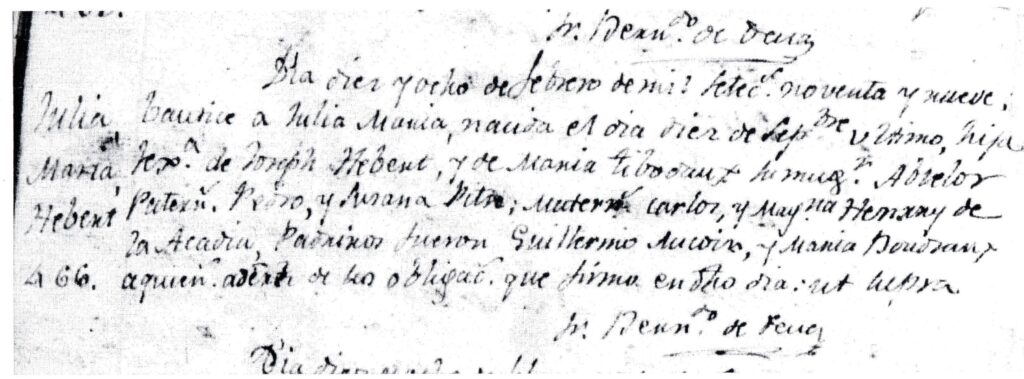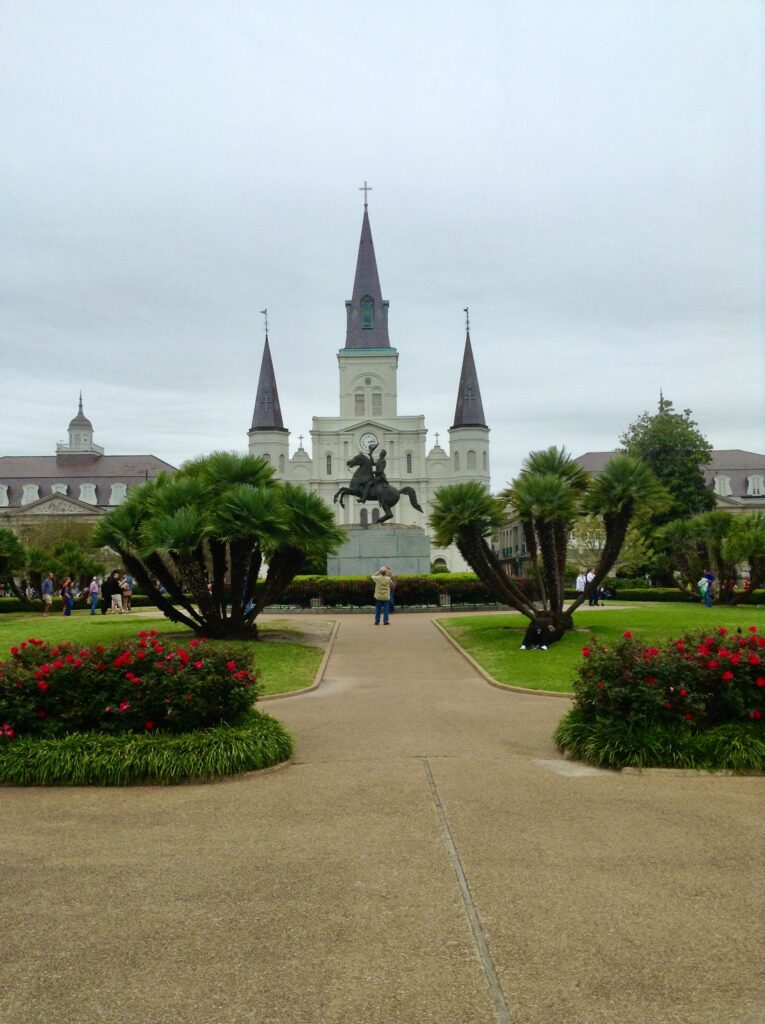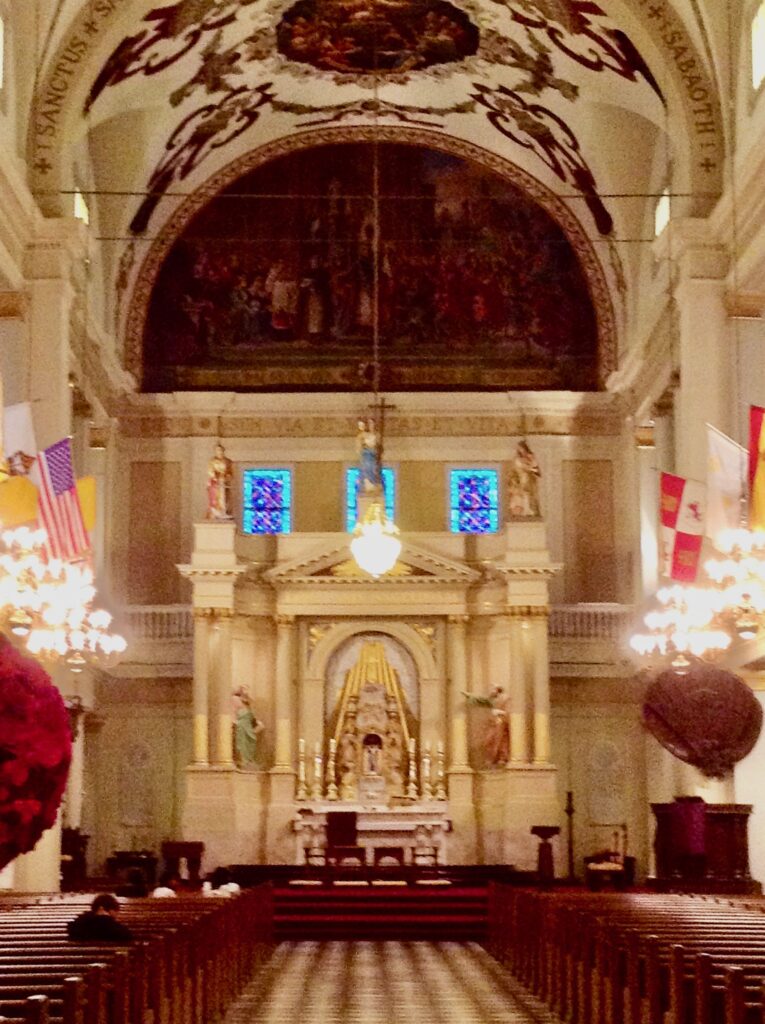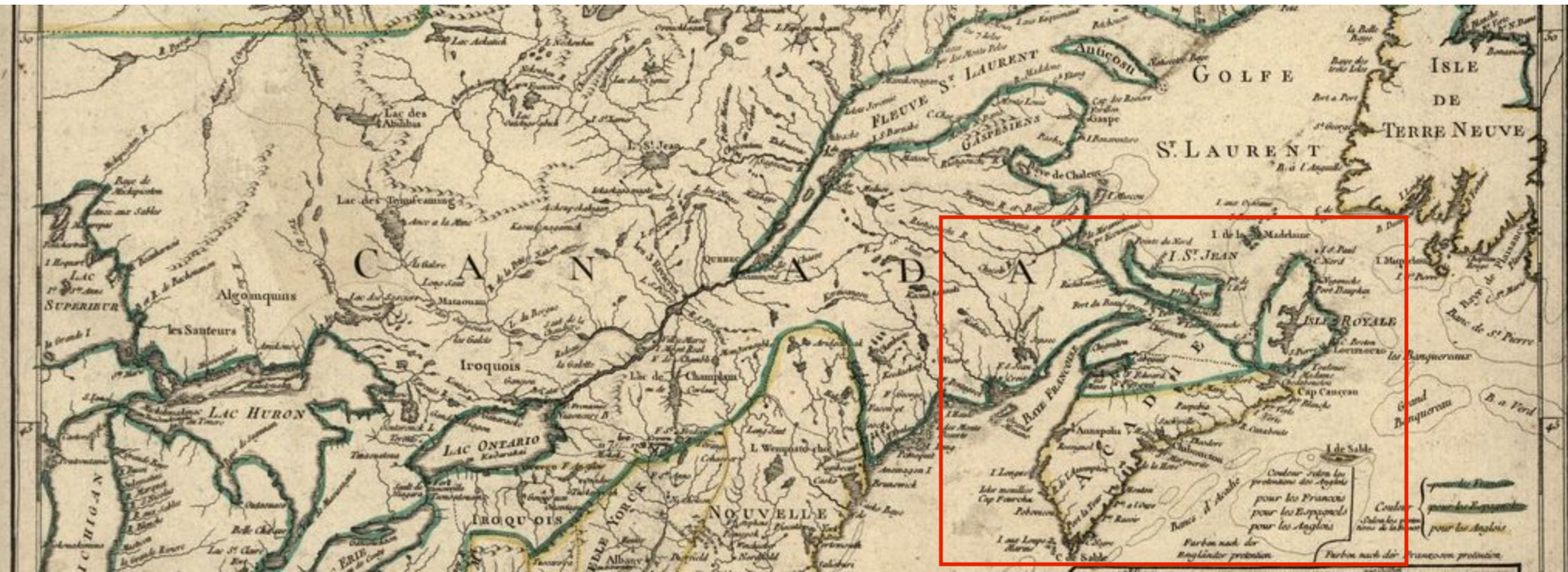My Fourth Great Grandmother
Daughter of Joseph-Yves Hebert and Marie Thibodeaux
Wife of Alexandre Delaune
Mother of Adelaide, Marie Celestine, Rosalie Clemence, infant boy, Seraphine Eve

Bon jour. I am Julie Marie Hebert. I was the first generation of my family to be born in Louisiana. I want to tell you the story of my life, my mère’s life, and my grand-mère’s life; but before I do, I should tell you a little history about Acadians and their arrival to Louisiana. I will not go into too much detail as you will learn more as our stories are told.
Acadians are the French people who colonized land in the 1600s that is now called Nova Scotia. Nova Scotia is east of Quebec. The French inhabitants called the land L’Acadie (Acadia) and the inhabitants became known as Acadians. In the 1700s France and England both claimed these lands and took turns controlling them. When England controlled L’Acadie in the mid-1700s, they expelled the Acadians because they would not pledge allegiance to England. There were two major deportations between 1755 and 1764. In the first deportation, over 6,000 Acadians were sent to many of the American colonies. In the last major deportation, about 3,500 Acadians were sent to France, their motherland. Though France was their motherland, and they were faithful to France, it had been about a century and several generations since any Acadian lived in France.
Map credit: Le Rouge, Georges-Louis. Canada et Louisiane. Paris, 1755. Map. Library of Congress. https://www.loc.gov/item/74695306/. The bottom map is and inset from the map on top with Acadia, Isle Royale, and Isle St. Jean in the red box, now known today as Nova Scotia, Cape Briton, and Prince Edward Island.
Some Acadians who were sent to France were there for twenty-six years before leaving. Not surprisingly the local inhabitants were worried that the Acadians would take their jobs and were not welcoming. The Acadians wanted land of their own.
During this same time, Spain was looking for Catholic people to colonize Louisiana and learned that the Acadians wanted a place where they could live together as they did in L’Acadie. As a result, the Spanish Crown financed the immigration of 1,600 Acadians to Louisiana. In 1785, seven ships left France for Louisiana. Those Acadians were later known as Cajuns, a corruption of the word Acadian.
Mother, daughter, granddaughter.
Magdalena Henry, Marie Victoire Thibodeaux, Julie Marie Hebert.
L’Acadie, France, Louisiana.
Magdalena Henry was Marie Victoire’s mother and Julie Marie was Marie Victoire’s daughter.
Now, in case you forgot, my name was Julie Marie Hebert. My grand-mère, Magdalena Henry was born in L’Acadie but died in Louisiana. My mère, Marie Victoire Thibodeaux was born in France after her mère was deported from L’Acadie, but Mère also died in Louisiana. I too died in Louisiana.
My life’s story is brief, but I witnessed three notable events: The Louisiana Purchase in 1803, Louisiana becoming a state in 1812 in the United States of America, and the Battle of New Orleans in 1815.
I was of the first generation in my family to be born in Louisiana. My grandparents had been born in L’Acadie but were deported to France in 1759. My parents Joseph-Yves Hebert and Marie Thibodeaux were Acadians born in France and then immigrated to Louisiana in 1785. Though my parents were not married yet, both were on the ship La Ville d’Archangel from France to Louisiana with their families. [1] Tim Hebert, “Passenger List for La Ville d’Archangel,” Acadian-Cajun Genealogy & History (http://www.acadian-cajun.com/ship6.htm : viewed 16 December 2021).
My birthday was 10 September 1798, and I was baptized 18 February 1799 at Assumption Catholic Church in Plattenville, Louisiana.[2]Diocese of Baton Rouge, Diocese of Baton Rouge Catholic Church Records (Diocese of Baton Rouge: Baton Rouge, Louisiana, 2009), 2:365. Citation reads “Julia Maria (Josef & Maria Tibodaux) bt. 18 … Continue reading This small church established in 1793 had an exceptionally long name: La Parroquia de l’Assumption de Nuestra Senora de la Fourche de los Chetimachas de Valenzuela (The Parish of Assumption of Our Lady of the Fork of the Chetimachas of Valenzuela.)[3]Emilie G. Leumas and Renée B. Richard, Roots of Faith: History of the Diocese of Baton Rouge (Éditions du Signe: Strasbourg, France, 2009), p. 26. My godparents were Guillermo (Guillaume in French) Aucoin and Maria Boudraux.[4]Diocese of Baton Rouge (1770-1803), 2:365. Many of our names were recorded in the church records as if we were Spanish instead of French as Louisiana was under Spanish rule at that time. So, someone named Pierre would be recorded as Pedro and someone named Scholastique would be recorded as Escolastica. What? You have never heard the name Scholastique? You have many ancestors with that name. The Spanish custom was also to include the names of grandparents in the baptismal records.

Julia Maria Hebert baptism, 10 September 1798, Assumption of the Blessed Virgin Mary Catholic Church (Plattenville, Louisiana), digital image from ASM-1, p. 130, entry 466, supplied 24 January 2022 by Diocese of Baton Rouge Archive. The digital image received from the archive was cropped to show only the selected baptismal record for Julia Maria Hebert.
I think my godparents may have been on the same ship from France with my family as there were nine Aucoin families and a Marie Boudrot on the passenger list.[5] Tim Hebert, “Passenger List for La Ville d’Archangel,” Acadian-Cajun Genealogy & History (http://www.acadian-cajun.com/ship6.htm : viewed 16 December 2021). In my time, spelling of surnames was never consistent. I am not even sure if I knew how to spell my name. I probably did not know how to read or write. Acadians did not usually send their children to school.
My mère had at least seven children. My three brothers and three sisters were Cirille, Joseph Mathurino, Maria Celestine, Contancia Escolastica, and Joseph Elias.
I think some of my father’s family lived with us when I was young. We lived near my father’s brother, Mathurin.[6]1810 U.S. Census, Assumption, Louisiana, population schedule, p.28, Maturin Hebert and Joseph Hebert households; National Archives and Records Administration (NARA) microfilm publication M252, roll … Continue reading Our homes were constructed very simply, usually one room. If there was any furniture, it had been made from the local cypress trees. Those of us who owned land along the rivers had to build and maintain levees to prevent flooding. The land was full of beaver, muskrat, bear, and, of course, alligators. We lived off the land and traveled along the bayous in little boats called pirogues. We were not a materialistic people. We mostly had only what we needed, we grew our own crops and women weaved cotton for clothing.
My husband was Alexandre Delaune. Before we married, we were neighbors.[7]1810 U.S. Census, Assumption, Louisiana, population schedule, p. 27-28, Ve. Jean Delaune and Joseph Hebert households; National Archives and Records Administration (NARA) microfilm publication M252, … Continue reading We married 29 May 1820 at St. Joseph’s in Thibodaux.[8]Rev. Donald J. Hebert, South Louisiana Records Church and Civil Records of Lafourche – Terrebonne Parishes, 12 vols. (Cecilia, Louisiana: Rev. Donald J. Hebert, 1978-1985), 1:78. Citation … Continue reading It is now known as St. Joseph’s Co-Cathedral Church. The original wooden church was built in 1819.[9]Churches, The Diocese of Houma-Thibodaux, (https://htdiocese.org/stjosephcocathedral : viewed 14 December 2021). We were one of the first couples to marry in that church. Alexandre’s parents had both died before we married. I understand my fourth great-granddaughter Sindi Broussard Terrien married her husband that same day, May 29th, in 1982 and she too was twenty-one years old when she married.
When my parents arrived in Louisiana, it was under Spanish rule. Then Spain essentially gave Louisiana back to France in 1800 and then France sold Louisiana to the United States of America in 1803. Historians call this the Louisiana Purchase. The United States practically doubled in size in one day! What a confusing time that was. The politics and discussions were so heated. There was a flag-raising ceremony in New Orleans in what is now Jackson Square on 20 December 1803. Then the United States divided the land purchased and the area in which we lived was known as the Territory of New Orleans. Again, there was so much political discussion going on. The area in which we lived did not become a state until 30 April 1812.
No sooner had Louisiana become a state, than the United States declared war on England in June 1812. The war had to do with trade restrictions and Britain’s practice of seizing American ships and impressing the American crews into the British Navy. I heard that the English soldiers captured Washington, D.C. and burned the Capitol. One of the last events of this war was British soldiers trying to take control of New Orleans because they could then control the Mississippi River.
General Andrew Jackson led the Americans in New Orleans. Many Acadians joined the effort. Before we were married, my husband served under Capt. B. Aycock in the Louisiana Militia in what was known as the Battle of New Orleans from December 1814 to March 1815.[10]“War of 1812 Pension and Bounty Land Warrant Application Files,” database and images, Fold3 (https://www.fold3.com/image/307849761 : accessed 3 December 2021); image of abstract … Continue reading Alexandre was about seventeen at the time. I was so proud of him though I do not really know how he participated. He probably took part in building fortifications and helped protect them in January 1815. On January 7, the Ursuline nuns and citizens of New Orleans and the surrounding area prayed for victory. The next day, the Americans won the victory. A Mass of Thanksgiving was held at St. Louis Cathedral in New Orleans. Alexandre served long enough to receive a pension and land grants.


I was twenty-three when I had my first child Adelaide.[11]Rev. Donald J. Hebert, South Louisiana Records Church and Civil Records of Lafourche – Terrebonne Parishes, 12 vols. (Cecilia, Louisiana: Rev. Donald J. Hebert, 1978-1985), 1:178. She was named after Alexandre’s sister. About a year later there was Marie Celestine who was named after my sister Maria Celestine.[12]Rev. Donald J. Hebert, South Louisiana Records Church and Civil Records of Lafourche – Terrebonne Parishes, 12 vols. (Cecilia, Louisiana: Rev. Donald J. Hebert, 1978-1985), 1:178. Rosalie Clemence was born two years later.[13]Rev. Donald J. Hebert, South Louisiana Records Church and Civil Records of Lafourche – Terrebonne Parishes, 12 vols. (Cecilia, Louisiana: Rev. Donald J. Hebert, 1978-1985), 1:178. Alexandre had a sister named Rosalie, so we named our little one after her. They were pretty, little girls. Then there was the little boy who lived for only four hours.[14]Rev. Donald J. Hebert, South Louisiana Records Church and Civil Records of Lafourche – Terrebonne Parishes, 12 vols. (Cecilia, Louisiana: Rev. Donald J. Hebert, 1978-1985), 1:178. I was heart-broken when I lost him. Three girls and finally a boy and he did not survive. Alexandre’s mère had had several boys who all died young leaving only one son, Alexandre. Then I was pregnant with my last child. Seraphine Eve was born about two years later, but I did not survive. I passed the next day, 7 March 1830 at the age of thirty-one.[15]Rev. Donald J. Hebert, South Louisiana Records Church and Civil Records of Lafourche – Terrebonne Parishes, 12 vols. (Cecilia, Louisiana: Rev. Donald J. Hebert, 1978-1985), 1:274. Poor Alexandre. He was lost for so long. I am not sure who helped him other than our oldest daughter Adelaide. More than likely one of my brothers or sisters or Alexandre’s sisters helped. But my daughters survived and had families of their own, even Seraphine. She married and had at least seven children. Alexandre lived a long life. He did marry again and had a son, Jean Augustin, but he too died.[16]Rev. Donald J. Hebert, South Louisiana Records Church and Civil Records of Lafourche – Terrebonne Parishes, 12 vols. (Cecilia, Louisiana: Rev. Donald J. Hebert, 1978-1985), 1:178.
Alexandre lived to the ripe old age of eighty-one years, but his Delaune line ended with his daughters.[17]Décès au Brûle Labadie,” Pioneer of Assumption (Napoleonville, Louisiana), 30 November 1878, p. 1, col. 3, Chronicling America Historic American … Continue reading His cousins continued the Delaune name to this day.
C’est la vie!
Next week I will tell you the story of my mère, Marie Victoire Thibodeaux and how she came to Louisiana when she was sixteen.
References
| ↑1 | Tim Hebert, “Passenger List for La Ville d’Archangel,” Acadian-Cajun Genealogy & History (http://www.acadian-cajun.com/ship6.htm : viewed 16 December 2021). |
|---|---|
| ↑2 | Diocese of Baton Rouge, Diocese of Baton Rouge Catholic Church Records (Diocese of Baton Rouge: Baton Rouge, Louisiana, 2009), 2:365. Citation reads “Julia Maria (Josef & Maria Tibodaux) bt. 18 Feb. 1799, bn. 10 Sept. 1798, spo. Guillermo Aucoin & Maria Boudraux, Pat. GP: (Pedro Hebert & Susana Pitre of Acadia) Mat. GP: (Carlos Tibodaux & Magdalena Henry of Acadia) (ASM-1, 130).” |
| ↑3 | Emilie G. Leumas and Renée B. Richard, Roots of Faith: History of the Diocese of Baton Rouge (Éditions du Signe: Strasbourg, France, 2009), p. 26. |
| ↑4 | Diocese of Baton Rouge (1770-1803), 2:365. |
| ↑5 | Tim Hebert, “Passenger List for La Ville d’Archangel,” Acadian-Cajun Genealogy & History (http://www.acadian-cajun.com/ship6.htm : viewed 16 December 2021). |
| ↑6 | 1810 U.S. Census, Assumption, Louisiana, population schedule, p.28, Maturin Hebert and Joseph Hebert households; National Archives and Records Administration (NARA) microfilm publication M252, roll 10; ancestry.com (https://www.ancestry.com/imageviewer/collections/7613/images/4433226_00031?pId=15214 : viewed 1 January 2021). |
| ↑7 | 1810 U.S. Census, Assumption, Louisiana, population schedule, p. 27-28, Ve. Jean Delaune and Joseph Hebert households; National Archives and Records Administration (NARA) microfilm publication M252, roll 10; ancestry.com (https://www.ancestry.com/imageviewer/collections/7613/images/4433226_00030?ssrc=&backlabel=Return, images : viewed 1 January 2021). |
| ↑8 | Rev. Donald J. Hebert, South Louisiana Records Church and Civil Records of Lafourche – Terrebonne Parishes, 12 vols. (Cecilia, Louisiana: Rev. Donald J. Hebert, 1978-1985), 1:78. Citation reads: “DELAUNE, Alexandre (d. Jean & d. Marianne PART) m. 29 May 1820 Julie HEBERT (Thib. Ch.: v, 1, p. 5).” |
| ↑9 | Churches, The Diocese of Houma-Thibodaux, (https://htdiocese.org/stjosephcocathedral : viewed 14 December 2021). |
| ↑10 | “War of 1812 Pension and Bounty Land Warrant Application Files,” database and images, Fold3 (https://www.fold3.com/image/307849761 : accessed 3 December 2021); image of abstract card for bounty-land warrant 41727and Alexander Delaune’s pension claim SO 30035, service of Alexander Delaune (Pvt Capt B Aycock’s Co La Mil); citing “War of 1812 Pension and Bounty land Warrant Application Files, compiled ca. 1871–1900, documenting the period 1812–ca.1900,” National Archives Catalog ID: 564415, Record Group 15, Roll RG15-1812PB-Bx0995, National Archives, Washington, D.C. |
| ↑11 | Rev. Donald J. Hebert, South Louisiana Records Church and Civil Records of Lafourche – Terrebonne Parishes, 12 vols. (Cecilia, Louisiana: Rev. Donald J. Hebert, 1978-1985), 1:178. |
| ↑12, ↑13, ↑14, ↑16 | Rev. Donald J. Hebert, South Louisiana Records Church and Civil Records of Lafourche – Terrebonne Parishes, 12 vols. (Cecilia, Louisiana: Rev. Donald J. Hebert, 1978-1985), 1:178. |
| ↑15 | Rev. Donald J. Hebert, South Louisiana Records Church and Civil Records of Lafourche – Terrebonne Parishes, 12 vols. (Cecilia, Louisiana: Rev. Donald J. Hebert, 1978-1985), 1:274. |
| ↑17 | Décès au Brûle Labadie,” Pioneer of Assumption (Napoleonville, Louisiana), 30 November 1878, p. 1, col. 3, Chronicling America Historic American Newspapers.com (https://chroniclingamerica.loc.gov/lccn/sn88064275/1878-11-30/ed-2/seq-1/#date1=1878&index=0&rows=20&words=Delaune&searchType=basic&sequence=0&state=Louisiana&date2=1878&proxtext=delaune&y=0&x=0&dateFilterType=yearRange&page=1 : viewed 3 December 2021). |



2 thoughts on “Julie Marie Hebert Delaune”
Comments are closed.